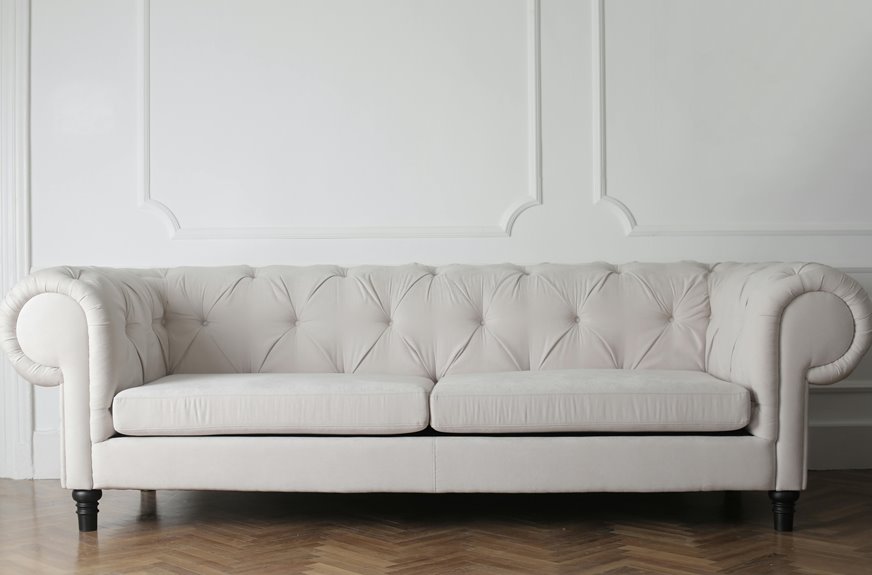To clean and condition leather upholstery properly, first identify your leather type to choose the right products. Start by dusting gently with a soft cloth or vacuum to remove surface dirt. Use a mild leather cleaner tested on a hidden spot, applying it sparingly in circular motions. After drying, condition the leather every 3 to 6 months to keep it soft and prevent cracking. Avoid harsh chemicals and direct sunlight to protect your leather’s finish. There’s more to know for flawless care and stain handling.
Table of Contents
Key Takeaways
- Identify the leather type to choose appropriate cleaning and conditioning products and avoid damage.
- Remove dust and debris gently with a soft cloth or vacuum using a brush attachment before cleaning.
- Test cleaners on a hidden area, then apply sparingly with a soft cloth in circular motions and wipe off residue.
- Condition leather every 3 to 6 months to maintain softness, prevent drying, and extend upholstery life.
- Blot spills immediately, avoid harsh chemicals, and seek professional cleaning for deep stains or persistent odors.
Understanding Different Types of Leather Upholstery
Before you plunge into cleaning and conditioning, it’s important to know the type of leather you’re dealing with. Different leathers respond differently to cleaning methods.
For example, full-grain leather is durable and develops a rich patina over time, so you can use gentle cleaners and conditioners without worry.
Top-grain leather has a thinner finish and requires more delicate care to avoid damage.
Split leather, often used in suede, needs specialized products to maintain its texture.
Corrected-grain leather has an artificial coating, meaning harsh chemicals can strip its finish.
By identifying the leather type, you avoid mistakes that could ruin your upholstery.
Knowing your leather type helps prevent damage and keeps your upholstery looking its best.
Check tags, ask the manufacturer, or test a hidden spot before applying any products.
This step guarantees your leather stays beautiful and lasts longer.
Essential Tools and Materials for Cleaning Leather
To care for your leather upholstery properly, you’ll need the right tools and materials.
Choose gentle cleaning solutions that won’t damage the leather, soft cloths that won’t scratch, and effective leather conditioners to keep it supple.
Let’s explore these essentials so you can maintain your leather’s beauty and durability.
Gentle Cleaning Solutions
When you clean leather upholstery, choosing gentle solutions is key to preserving its natural texture and preventing damage.
Avoid harsh chemicals like ammonia or bleach, as they can dry out and crack the leather. Instead, opt for a mild soap diluted in water—such as a few drops of dish soap or a specialized leather cleaner.
Test any solution on a hidden spot first to verify it doesn’t discolor or harm the leather. Use just enough moisture to lift dirt without soaking the material.
Gentle cleaning solutions help maintain the leather’s softness and extend its lifespan, so you don’t have to worry about stripping away oils or causing stiffness.
Soft Cloth Types
Choosing the right soft cloth is essential for cleaning leather effectively without causing damage.
You’ll want to use a microfiber cloth because it’s gentle, lint-free, and highly absorbent, making it perfect for wiping away dirt and cleaning solutions without scratching the leather’s surface.
Cotton cloths can also work well, especially soft, tightly woven ones like old t-shirts or pillowcases, but avoid anything abrasive.
Avoid paper towels or rough fabrics since they can leave scratches or fibers behind.
Always use a clean cloth to prevent transferring dirt back onto the leather.
For different cleaning stages, keep separate cloths: one damp for applying cleaner and another dry for buffing.
This approach guarantees you maintain your leather’s smooth texture and vibrant appearance without harm.
Leather Conditioner Options
After selecting the right cloths for cleaning, you’ll want to focus on picking the best leather conditioner to keep your upholstery soft and protected.
Choosing the right conditioner depends on your leather type and the level of care it requires. Some options penetrate deeply, restoring moisture, while others create a protective surface layer. Look for conditioners that are free from harsh chemicals to avoid damage.
Here are three popular leather conditioner options:
- Cream-based conditioners: Provide deep hydration and a natural finish.
- Oil-based conditioners: Great for restoring flexibility but use sparingly to avoid darkening.
- Spray conditioners: Easy to apply and ideal for quick touch-ups.
Test any product on a hidden area first to verify compatibility with your leather.
How to Remove Dust and Surface Dirt Safely
Because leather is sensitive to harsh abrasives, you’ll want to start by gently removing dust and surface dirt with a soft, dry cloth or a vacuum cleaner fitted with a brush attachment.
Use light pressure to avoid scratching the surface. Focus on crevices and seams, where dust often accumulates. If you use a vacuum, keep the suction low and move the brush attachment in gentle, circular motions.
Avoid using rough fabrics or paper towels, as they can cause damage. Regularly removing dust this way prevents buildup that can wear down the leather’s finish.
Choosing the Right Leather Cleaner for Your Upholstery
Once you’ve cleared away dust and surface dirt, the next step is to select a leather cleaner that suits your upholstery’s specific type and finish.
Using the wrong cleaner can damage the leather or strip its natural oils, so it’s essential to pick carefully. Start by identifying whether your leather is aniline, semi-aniline, or protected. Then, choose a cleaner formulated for that kind.
Keep these tips in mind when choosing a cleaner:
- Look for pH-balanced, non-alkaline formulas to avoid drying out the leather.
- Avoid harsh chemicals like ammonia or bleach that can cause discoloration.
- Opt for products with moisturizing ingredients to help maintain suppleness.
Selecting the right cleaner guarantees your leather stays beautiful and lasts longer.
Step-by-Step Guide to Cleaning Leather Upholstery
Cleaning leather upholstery involves a few essential steps that make certain you preserve its texture and appearance.
First, vacuum the surface gently using a soft brush attachment to remove dust and debris.
Next, test your chosen leather cleaner on a hidden spot to confirm it won’t cause discoloration.
Apply the cleaner sparingly with a soft cloth in circular motions, avoiding excessive moisture.
Wipe away the residue with a clean, damp cloth, then dry immediately with a dry towel.
Pay attention to seams and crevices where dirt can accumulate.
Repeat the process if necessary, but avoid over-cleaning, which can damage the leather.
Following these steps carefully keeps your upholstery looking fresh without compromising its quality.
How to Condition Leather to Maintain Softness
To keep your leather upholstery soft and supple, you’ll need to pick the right conditioner suited for your leather type.
Applying it correctly guarantees the conditioner penetrates without leaving residue or buildup.
Also, knowing how often to condition will help maintain that fresh, flexible feel over time.
Choosing the Right Conditioner
Selecting the right conditioner plays an essential role in keeping your leather upholstery soft and supple. You want a product that nourishes without leaving a sticky residue or altering the leather’s natural appearance.
Here’s what to look for:
- Natural Ingredients: Choose conditioners with oils like mink oil or lanolin to hydrate leather deeply without harsh chemicals.
- pH-Balanced Formula: Verify the conditioner matches leather’s pH to prevent drying or cracking over time.
- Non-Toxic and Odorless: Pick a product free from strong scents and harmful substances, especially if you’re sensitive to smells or have pets.
Application Techniques
While conditioning leather may seem straightforward, applying the product correctly guarantees your upholstery stays soft and lasts longer.
Start by testing the conditioner on a small, hidden area to verify it won’t discolor the leather. Use a clean, soft cloth or sponge to apply a thin, even layer of conditioner. Work it in gently with circular motions, covering every inch without saturating the leather.
Allow the conditioner to absorb fully—usually about 10 to 15 minutes. Afterward, buff the surface lightly with a dry cloth to remove any excess product and restore the leather’s natural sheen.
Avoid applying too much conditioner at once, as this can lead to buildup or a sticky finish. Proper application keeps your leather supple and protects it from drying out.
Frequency of Conditioning
Regularly conditioning your leather upholstery is key to keeping it soft and preventing cracks.
How often you condition depends on factors like usage, climate, and leather type. Generally, you should condition your leather every 3 to 6 months to maintain its suppleness.
In dry climates or with heavy use, more frequent conditioning is helpful. Over-conditioning can clog pores, so balance is important.
Consider these tips for frequency:
- Condition lightly every 3 months in dry or hot environments.
- For less used pieces, 6-month intervals usually suffice.
- Always check your leather’s feel and appearance; if it’s drying out, it’s time to condition.
Tips for Handling Stains and Spills on Leather
Accidents happen, and when they do on your leather upholstery, quick action is key to preventing stains from setting. Blot spills immediately with a clean, dry cloth—never rub, as that can spread the stain. Use a slightly damp cloth for sticky residues, and always test any cleaning product on a hidden area first.
| Stain Type | Quick Fix |
|---|---|
| Water | Blot with dry cloth, air dry |
| Oil/Grease | Sprinkle baking soda, wipe gently |
| Ink | Dab with rubbing alcohol lightly |
| Food/Beverage | Wipe with damp cloth, mild soap |
Act fast, avoid harsh chemicals, and keep your leather looking great.
Preventative Care to Avoid Leather Damage
Taking proactive steps can greatly extend the life of your leather upholstery. By caring for it regularly and avoiding common hazards, you prevent damage and maintain its natural beauty.
Proactive care keeps leather upholstery beautiful and durable by preventing damage and preserving its natural charm.
Here’s how you can protect your leather:
- Keep it out of direct sunlight: Prolonged exposure causes fading and drying.
- Avoid placing sharp objects nearby: Scratches and punctures are hard to fix.
- Use a leather conditioner every 6 months: This keeps the leather supple and prevents cracking.
Regular dusting with a soft cloth also helps remove dirt that can wear down the surface over time.
When to Seek Professional Leather Cleaning Services
How do you know when your leather upholstery needs professional cleaning? If you notice deep stains, persistent odors, or discoloration that regular cleaning can’t tackle, it’s time to call in experts.
Professionals have specialized tools and solutions that safely lift grime without damaging leather’s delicate surface. Also, if your leather feels stiff, cracked, or excessively dry despite conditioning, a professional can restore its suppleness and extend its life.
Avoid trying harsh chemicals or abrasive methods yourself, as these can worsen the damage. When dealing with vintage, expensive, or heavily soiled pieces, professional cleaning guarantees the best care and protection.
Don’t wait for visible damage to worsen—regular professional maintenance can keep your leather looking its best longer.
Frequently Asked Questions
Can Leather Upholstery Be Cleaned With Household Vinegar?
Think of vinegar as a storm—it can cleanse but also damage. You shouldn’t clean leather upholstery with household vinegar since its acidity may strip oils, leaving your leather dry and cracked. Choose gentler, leather-specific cleaners instead.
How Often Should Leather Upholstery Be Cleaned Professionally?
You should get your leather upholstery professionally cleaned every 12 to 18 months. Regular professional care keeps it looking great, removes deep dirt, and maintains its durability, especially if you use your furniture daily.
Is It Safe to Use Baby Wipes on Leather Furniture?
You shouldn’t use baby wipes on leather furniture since they may contain alcohol or chemicals that dry out or damage the leather. Instead, use a cleaner specifically designed for leather to keep it safe and conditioned.
Can Leather Upholstery Be Restored After Water Damage?
You can restore leather upholstery after water damage if you act quickly. Dry it gently, clean with a leather-safe cleaner, and condition it well. Severe damage might need professional repair to fully restore its look.
Does Conditioning Leather Prevent Fading From Sunlight?
Think of leather as your skin; conditioning acts like sunscreen, shielding it from sunlight’s harsh kiss. While it can’t completely stop fading, regular conditioning definitely slows the process and keeps your leather supple and vibrant longer.
- A Beginner’s Guide to Nonwoven Fabric Types - July 11, 2025
- Spunbond vs. Spunlace: What’s the Difference in Nonwoven Fabrics? - July 11, 2025
- The Ultimate Comparison: Woven vs. Nonwoven Fabric Properties - July 11, 2025







